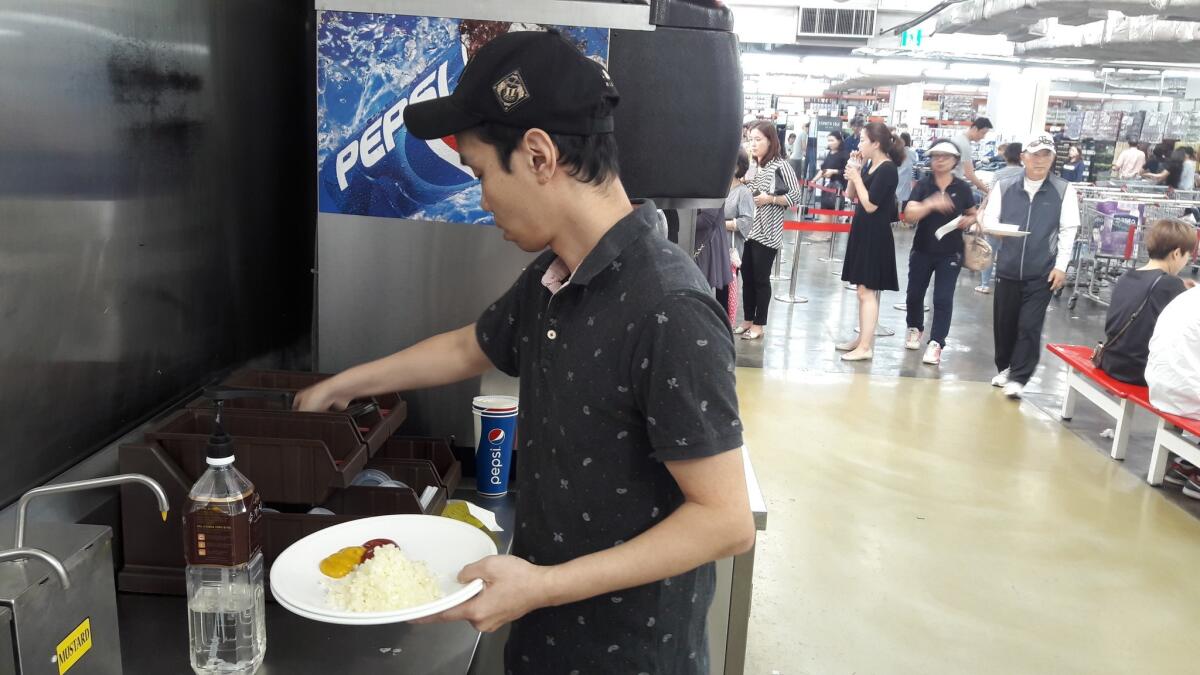Costco stores in South Korea offer chopped onions for hot dogs. Koreans have a different idea
- Share via
Reporting from SEOUL — The sound of silverware scraping plates reverberates through the Costco cafe, competing with the chatter of customers.
It is the sound of scooping onions.
Chopped onions are being scooped onto hot dogs, onto baked bulgogi sandwiches — and directly into people’s mouths, along with healthy dollops of mustard and ketchup. One aficionado calls it “onion salading.”
The menus inside Costco Wholesale food courts in South Korea have the company’s familiar spartan decor and mix of hearty and cheap options: pizza slices, baked sandwiches, hot dogs.
Here, though, there’s one noticeable exception — and it’s clear right away from the smell.
Inside the discount retailer’s cafes, customers have taken to heaping mounds of freshly chopped white onions — the kind intended as hot dog toppings — to fill their plastic plates, along with ample servings of ketchup and mustard.
South Koreans, it seems, have invented their own, indigenous Costco side dish, sometimes called Costco kimchi.

The dishes give the cafes here a distinctly Korean vibe, despite the vigorous devouring of the typically American fare, which also includes mushroom soup and smoothies.
The company’s food service managers have noticed.
Costco cafe customers in South Korea consume 20 times the amount of onions as their American counterparts each year, according to company data.
Put another way: American customers eat, on average, about 8 grams per hot dog sold in United States stores — the equivalent of about two teaspoons. In South Korea, the consumption — more than 200 tons annually at 13 Costco locations around the country — represents about 100 grams per dog, more than 10 times as much. South Koreans may purchase fewer hot dogs, but the love for onions is clear.
These onions go down amid what at times can be a crowded, chaotic scene, in which diners wait for seats and jostle for access to condiment dispensers, trash cans, silverware bins and soda machines.
Consumption methods vary by customer. Some prefer a large, clean mound of onions, with sauces placed in careful circles on the side. Some decorate the onions with sauce. Others still mix it all together into a red-orange mass.
Scores of these customers’ creations have been posted on social media such as Instagram. There’s even a mini-documentary about the practice.

The onions help the locals bring their palates to a foreign menu. “It’s an extension of that dietary culture,” said Jeon Won-il, sitting with an onion plate and sandwiches during a recent meal with his wife, Lee Jin-hee.
Indeed, customers such as Jeon and Lee said the onion trend relates directly to Koreans’ tradition of banchan, the small, communal side dishes, such as kimchi, served with meals here.
These dishes — some rich with the flavor of garlic, a cousin to the onion — are staples of the Korean diet. They give meals variety, and Koreans can’t imagine life without them.
In a statement, Costco attributed the “significant” onion consumption to this side dish tradition.
Costco has been in operation here since 1998, with stores in major cities, but it’s unclear when the onion salads started appearing.
For some, the idea seemed obvious from the first sight of the shiny dispensers, which have a round lever to spin out the chopped onions — like those at a hot dog stand at a baseball game.
Others just followed their peers.
Seo Yeon-ji, who ate a meal recently with her family, said she started making the side dish to complement her baked sandwich or pizza when she saw others doing it. “It suits our taste, and onions are also very healthy for us,” she said.
Daniel Gray, a food consultant who runs two restaurants here, agreed. He said South Koreans demand balance, especially with greasy Western foods. The free onion dishes also exemplify the expectation here for both flavor and generous customer service, he said.
“They need something like a pickle or a kimchi, in a way,” said Gray, an ethnic Korean who moved to Seoul from the United States more than a decade ago.
Na Kyeong-chae agrees that the onions balance out his meals. “It tastes better when I eat the onions with the pizza or sandwiches. It’s less greasy,” he said after spinning the dispenser to fill an onion plate, dotting it carefully with ketchup and mustard on the side.
For Westerners, the practice can seem bizarre, even stomach-turning. Some have also crafted cultural theories to explain the phenomenon.
Guy Citron, a New Jersey native who lives in Seoul, believes he coined the term “onion salading” years ago. But his idea comes from a business, not culinary, perspective.
Citron moved to Korea years ago to teach English. He has since learned the language, married a Korean woman and launched a video production company here.
He sees parallels between the Costco onion phenomenon and how his video clients, on occasion, take advantage of his willingness to offer services for free, such as extra project editing. He said the Costco onion phenomenon taught him an entrepreneurial lesson.
“Don’t ever put yourself in a position where you’re offering something and you allow the customer to think it’s complimentary,” he said. “Otherwise, you open yourself up to getting squeezed for a whole plate of onion salad.”
Stiles is a special correspondent.
ALSO
American rap, local whiskey: Tiny Bhutan guards tradition as it opens up to the world
Pache, a stew of sheep and cow innards, may not look appetizing, but the people of Mosul adore it
Mexico expels North Korean ambassador over nuclear tests
More to Read
Sign up for Essential California
The most important California stories and recommendations in your inbox every morning.
You may occasionally receive promotional content from the Los Angeles Times.











